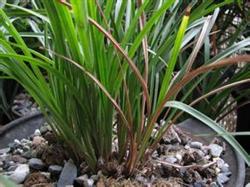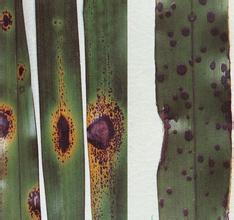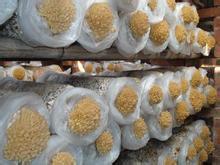Prevention and control of orchid anthracnose

Anthracnose is one of the main diseases of orchid cultivation, which is common in China, and it is a serious disease of orchids. In addition to orchids, it also harms poinsettia, jasmine, privet, bergamot, hibiscus and so on. First, the characteristics of symptoms: small reddish-brown spots appeared on the leaves at the beginning of the disease, and then expanded into large spots from grayish brown to gray-white. The lesions on the leaves are semicircular, round, oval, diamond-shaped and even irregular in size, ranging in length from 0.5 to 1.2 cm and width from 0.3 to 0.5 cm. Some of the disease spots were connected to each other into large patches or gradually withered from the tip of the leaf. The disease spot is dark brown, or the middle part is grayish white, and some disease spots are surrounded by yellowish green halos. In the later stage, there are needle-like small black spots (bacterial conidial disk) scattered on the disease spot, which is easy to break through the pathogenic spot, causing leaf withering and yellow segment-like death, reducing the ornamental value. Second, the pathogen and occurrence regularity: the pathogen is Colletotrichum anthracis. The pathogen overwintered with mycelium and conidial disk on diseased leaves or remnants of fallen soil. Conidia are produced the following year, which are spread by rain and insects and invade from stomata and wounds. The optimum temperature for conidia germination is 20 to 25 ℃, and the relative humidity is more than 80%. The overwintering period is not obvious in Guangzhou, and it can be infected when the temperature and humidity are suitable in early spring, especially in the high temperature, rainy season and continuous rainy weather from May to June, or in the years with more autumn rain or typhoon from September to October. In particular, the disease can be aggravated by high humidity and muggy, sometimes sunny and sometimes rainy (or showers) weather, poor management of fertilizer and water, over-dense pots, staggered abrasions of leaves, freezing injury of plants and so on. Potted orchids also occur all the year round in greenhouses or families in the north, such as too dense plants, spray watering, frost damage, over-sticky basin soil, poor drainage and so on. Third, prevention and control methods ① to strengthen the maintenance and management of orchids: such as planting is not too dense, pay attention to avoid frost and frost damage, try not to hurt plants in the maintenance process. Should not use porcelain pot planting, watering as far as possible choose irrigation, do not drench. The room should be ventilated and transparent. Rational fertilization, increase the application of phosphorus and potassium fertilizer, enhance the disease resistance of orchids. ② eliminates pathogens: cut off diseased leaves in winter and spring, remove fallen leaves and pull out diseased leaves and residual leaves in time, and burn them centrally to reduce the source of infection. Then 0.5% to 1% Bordeaux solution was sprayed on the ground, basin and plant once or twice. ③ chemical control: at the initial stage of the disease, the disease can be controlled by spraying 8-1000 times of the shark, 50% of anthrax Fumei wet powder or 2000 times of Teflin wet powder, once every 10 days for 3 to 4 times. In the severe stage of the disease, 2000-3000 times liquid of Spencer can be sprayed. During the onset of the disease, 50% compound carbendazim wet powder can be used, or 50% mixed thiophanate suspension should be 1000 to 1500 times, 50% should be 1000 times of Baoli wet powder. Or 69% Anke mancozeb + 75% chlorothalonil wettable powder (1 ∶ 1) 1000 to 1500 times liquid, 65% chlorothalonil wettable powder liquid, 75% chlorothalonil wettable powder + 70% Gaole wettable powder 1000 to 1000 times or 25% Chlorothalonil 500 times, sprayed every 7 to 10 days, alternately 3 to 4 times, the control effect is obvious. ④ regular spray to protect newborn leaves: it can be sprayed with 8-1000 times liquid of must shark, 1% Bordeaux solution, 75% chlorothalonil + 70% thiophanil (1 ∶ 1), 80% anthrax Fumei 600 times, 50% benzoate wettable powder 800 times, or 20% tricyclazole 800 times, spray once every 7 to 10 days, 3 to 4 times in a row, the control effect is good.
- Prev

Symptoms and control methods of orchid round spot disease
Spot disease is a common leaf disease of orchids, distributed in Fujian, Jiangsu, Zhejiang, Shanghai, Nanjing and other places. Symptoms: the disease mainly harms leaves. In the early stage, there are small brown spots on the leaves, which rapidly expand into a round color, wide, light brown in the middle, with yellow protuberances on both sides, occurring on the upper part of the leaf.
- Next

Spraying rare Earth solution to promote the growth of Flammulina velutipes
In the cultivation of Flammulina velutipes, spraying rare earth solution on the mushroom bed (culture bag) can promote the mycelium growth and improve the yield and quality of Flammulina velutipes. The specific method is: spray rare earth solution every 3 days, spray 500 milliliters per square meter of mushroom bed, and spray clear water every day to maintain relative humidity.
Related
- Fuxing push coffee new agricultural production and marketing class: lack of small-scale processing plants
- Jujube rice field leisure farm deep ploughing Yilan for five years to create a space for organic food and play
- Nongyu Farm-A trial of organic papaya for brave women with advanced technology
- Four points for attention in the prevention and control of diseases and insect pests of edible fungi
- How to add nutrient solution to Edible Fungi
- Is there any good way to control edible fungus mites?
- Open Inoculation Technology of Edible Fungi
- Is there any clever way to use fertilizer for edible fungus in winter?
- What agents are used to kill the pathogens of edible fungi in the mushroom shed?
- Rapid drying of Edible Fungi

